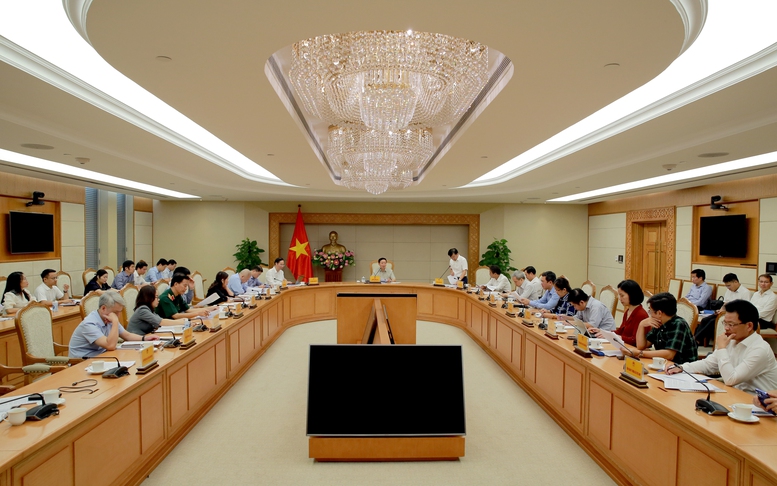Considering Extending the High-Speed Rail Route from Móng Cái to Cà Mau
During a meeting on September 25th regarding the deployment of the high-speed rail project on the North-South axis, Deputy Prime Minister Trần Hồng Hà requested the Ministry of Transport to absorb and implement the directions of the Central Committee, the Politburo, as well as the dedicated suggestions from ministries, sectors, experts, and people. He also emphasized the need to continuously update and finalize the pre-feasibility report for submission to the National Assembly, focusing on issues with practical and scientific foundations.
Specifically, in addition to the investment scope from the project’s starting point in Hanoi to the endpoint in Ho Chi Minh City, it is necessary to consider and study the option of extending the high-speed rail route from Móng Cái in the north to Cà Mau in the south.
The Deputy Prime Minister instructed the Ministry of Transport to “analyze the advantages and benefits of investing in the full line, which will synchronously connect with other transport modes, as compared to investing in certain sections first. Assess the effectiveness of the high-speed rail dedicated to passenger transport (or combining freight transport if necessary) for the entire economy, not just the railway sector.”

Deputy Prime Minister Trần Hồng Hà at the meeting. Photo: VGP/Minh Khôi
Additionally, the pre-feasibility report should reflect the view of constructing the railway with a design speed of 350 km/h, aiming for the “straightest possible” route, even if it means “going through mountains and building bridges over rivers.”
According to the report by Deputy Minister of Transport Nguyễn Danh Huy, the investment objectives of the project include striving for approval of the investment policy before 2025; land clearance and commencement of construction before 2030; and completion of the entire route before 2045.
The investment scope of the project has its starting point in Hanoi: the Ngọc Hồi station complex (the southern transport hub for passengers and cargo of the Hanoi railway hub). The endpoint is in Ho Chi Minh City: Thủ Thiêm station (the eastern transport hub for passengers of the Ho Chi Minh City railway hub).

Delegates at the meeting on the deployment of the high-speed rail project. Photo: VGP/Minh Khôi
The project passes through 20 provinces and cities, including: Hanoi, Ha Nam, Nam Dinh, Ninh Binh, Thanh Hoa, Nghe An, Ha Tinh, Quang Binh, Quang Tri, Thua Thien – Hue, Da Nang, Quang Nam, Quang Ngai, Binh Dinh, Phu Yen, Khanh Hoa, Ninh Thuan, Binh Thuan, Dong Nai, and Ho Chi Minh City.
The project involves a double-track railway, with a standard gauge of 1.435 mm, electrification, a design speed of 350 km/h, and an axle load of 22.5 tons. It is approximately 1,541 km long and includes 23 passenger stations and 5 freight stations. The high-speed rail will primarily transport passengers, with the ability to transport cargo if necessary, and it will also serve national defense and security purposes. The existing North-South railway will be utilized for cargo transport and short-distance tourist trips, with an estimated investment of 60-70 billion USD.
What Are the Benefits of Building a High-Speed Rail from Móng Cái to Cà Mau?
Constructing a high-speed rail to Móng Cái offers numerous advantages and brings economic, commercial, and tourism benefits, especially when considering the potential for cross-border connections to China. Being located near the Chinese border, building a high-speed rail to Móng Cái would open up opportunities to integrate with China’s railway network.
This integration would facilitate trade, tourism, and international exchange, expanding Vietnam’s import and export markets. Connecting the high-speed rail to China would reduce transportation costs and delivery times, enhancing the competitiveness of Vietnamese goods in the international market.

Móng Cái – at the northern frontier of Vietnam. Photo: Lao Dong
Furthermore, the high-speed rail would attract more tourists from China and other countries to Vietnam. This is particularly significant in boosting the tourism industry, especially in the northern provinces.
Having a high-speed rail line would also reduce the pressure on land border gates, facilitating faster movement of goods, alleviating congestion, and improving customs clearance efficiency.
Additionally, constructing a high-speed rail to Đất Mũi Cà Mau – the southernmost point of Vietnam – offers significant benefits, especially for the socio-economic development and tourism of the Mekong Delta region.
The Mekong Delta has great potential in agriculture, aquaculture, and tourism, but its weak transport infrastructure has been a major hindrance. A high-speed rail would enhance connectivity, spur economic growth, and provide a boost to industries, services, and other economic sectors in the region.
Moreover, Đất Mũi Cà Mau is a renowned tourist destination, featuring unique natural landscapes, a UNESCO Biosphere Reserve, and distinctive cultural characteristics of the water-based region. The high-speed rail would attract more domestic and international tourists, contributing to the promotion of Cà Mau’s tourism image.

Mũi Cà Mau. Photo: Báo Cà Mau
With low transport costs and quick travel times, the high-speed rail would reduce logistics expenses and facilitate the transportation of agricultural and aquatic products from Cà Mau and its neighboring provinces to major consumption centers or export markets.
The high-speed rail project would create numerous job opportunities and improve the income and living standards of local residents through associated services such as stations, hotels, restaurants, and logistics services.
Thai Ha
The First Cable-Stayed Bridge in Vietnam: Locally Designed and Constructed, Unlocking Provincial Isolation with Domestic Funding.
The project boasts an impressive investment of approximately 1,400 billion VND, with a breakdown of 58% state budget funds and 42% sourced through a Build-Operate-Transfer (BOT) scheme.
The Power of Delegation: Empowering Local Leadership for Efficient Governance
Inaugurating the Government’s law-themed session on the morning of September 23rd, Prime Minister Pham Minh Chinh emphasized the need to enhance decentralization and delegation of authority. He stressed that subordinates should not have to “ask” for permission from higher-ups for every minor matter and that decisions should be based on established regulations. The Prime Minister underscored the importance of empowering lower levels of government to make decisions independently, without having to seek approval from the central authorities for every trivial issue.
SpaceX Plans to Invest Billions in Vietnam in the Coming Years
SpaceX’s Senior Vice President, Tim Hughes, has stated that Vietnam is a highly promising market for the company’s satellite internet development plans. The corporation intends to invest billions of dollars in the country in the coming years, recognizing the potential for growth and expansion within the Vietnamese market.



















